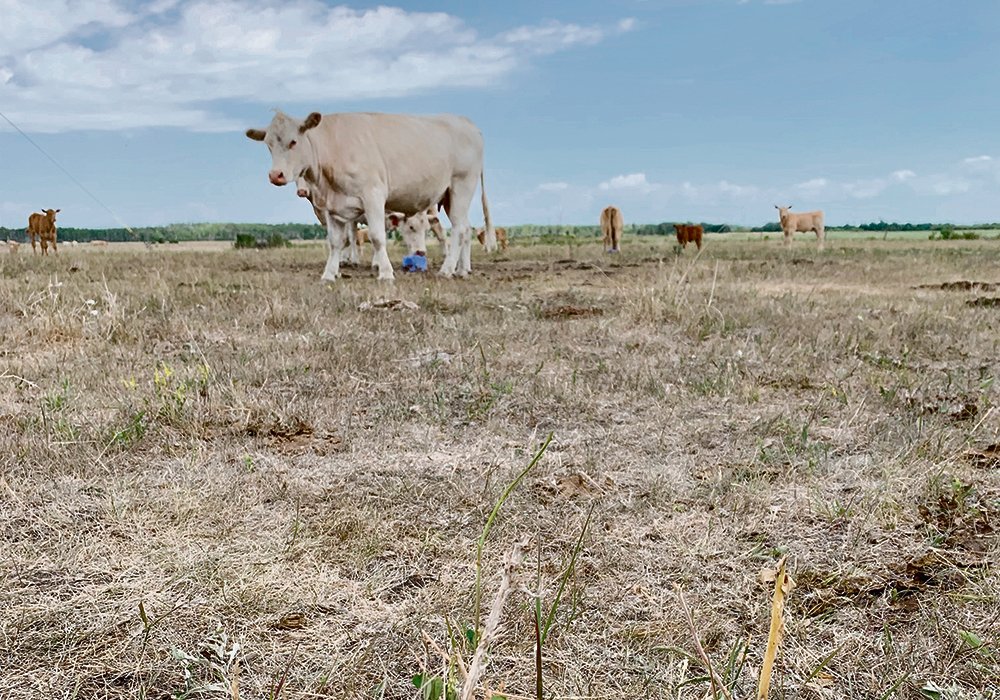Cattle head to auction markets as Manitoba pastures dry up

The Ashern Auction Mart doesn’t normally hold sales in the summer.
That’s because cows and calves are on pasture and producers don’t have a need to market their cattle.
But in early July, the auction market, about 180 kilometres north of Winnipeg, held a sale “due to the drought,” its website says.
On July 7, 949 cattle were up for sale in Ashern: 539 feeder cattle and 386 slaughter cattle.
“It’s been years and years since we had a mid-July sale,” said Ray Bittner, an auction mart director and farmer from Moosehorn, which is north of Ashern, in the province’s Interlake region.
Cattle ranchers in the Interlake and Westlake regions of Manitoba are selling cattle because pastures and hayland in the province are dead or dying. Since last summer, below normal rain and snow has fallen on southern Manitoba.
“If you drive down the roads around here, there are a lot of pastures that are orange,” said Bittner, a former livestock specialist with Manitoba Agriculture who grows crops and raises about 100 head of beef cows. “After the heat dome (with 37 C temperatures in early July), the grass got so stressed it turned orange.”
Things are so bad that the Rural Municipality of St. Laurent, south of Ashern, declared an agricultural disaster July 6. Grasshoppers and the lack of rainfall have severely damaged the forage and annual crops in the RM.
Around Moosehorn, there are few options for harvesting forage this summer.
The alfalfa and native hay are in poor shape.
“If you have lowland native hay … a lot of that got damaged by frost (this spring),” Bittner said. “If you have highland native hay, that’s probably un-harvestable because the grasshoppers have eaten it.”
Manitoba’s agriculture minister, Blaine Pedersen, is worried that cattle ranchers throughout the province will sell a substantial number of their stock this summer.
To preserve Manitoba’s cattle herd, Pedersen met last week with Manitoba Beef Producers, Keystone Agricultural Producers, the Manitoba Forage and Grassland Association and the Association of Manitoba Municipalities.
The groups and the province will work together to help livestock producers with feed supplies and other impacts from the drought.
“I expect that cattle producers are going to cull hard…. But we are really trying to avoid this mass sell-off,” Pedersen said in a media call. “We want to try and maintain that cow herd for future years. In order for producers to do that, they need some help somewhere along the lines…. That’s why we formed this working group.”
They will meet again, soon, after the individual groups have consulted with their members on the best way to provide assistance.
Livestock producers in much of Manitoba are worried about pasture regrowth and poor forage yields, but conditions are likely the most severe in the Interlake and Westlake — west of Lake Manitoba.
“The poor soils combined with three dry years in a row… it’s not good,” said Tim Clarke, a livestock specialist with Manitoba Agriculture.
“The pastures are dry. They’re going dormant…. Plus the grasshoppers, they do better when it’s hot and dry, so they’re cleaning off what little grass is growing.”
With pastures in rough shape, producers may need to take their cattle off pasture this summer. That means they will need more feed to last until next spring, but cattle producers have few forage options right now.
Farmers like Bittner who grow annual crops will have straw for their cattle, or a cereal crop that can be harvested for feed. But ranchers who don’t have annual crops may find it difficult to buy feed.
In some years, cattle producers in the Interlake purchase straw from grain farmers in Manitoba’s Red River valley, but crops are short this year because of the lack of rainfall and poor soil moisture across much of the province, so there won’t be an abundance of straw this fall.
Purchasing hay is also an option, but it may not make economic sense.
“Where do you go to buy feed?” Bittner asked. “I heard a guy (in the Interlake) bought a couple of semi-loads of round bales from Saskatchewan at $150 per bale. That doesn’t pencil (out).”
When all the factors are combined — the persistent drought, the brutal 34 C days this summer and a terrible forage crop — some cattle producers in the Interlake are losing faith.
“There’s a lot of hopelessness, to be honest,” said Bittner, describing the mood among ranchers.
Pedersen and the province have been trying to provide feed options and hope, such as opening non-leased crown lands for grazing and haying. Farmers needing information about alternative feed supplies may want to check the Manitoba Forage & Grassland website, which provides some useful links: mfga.net/hay-relief.
As well, a list of services to help with water supplies can be found here.
Source: www.producer.com

